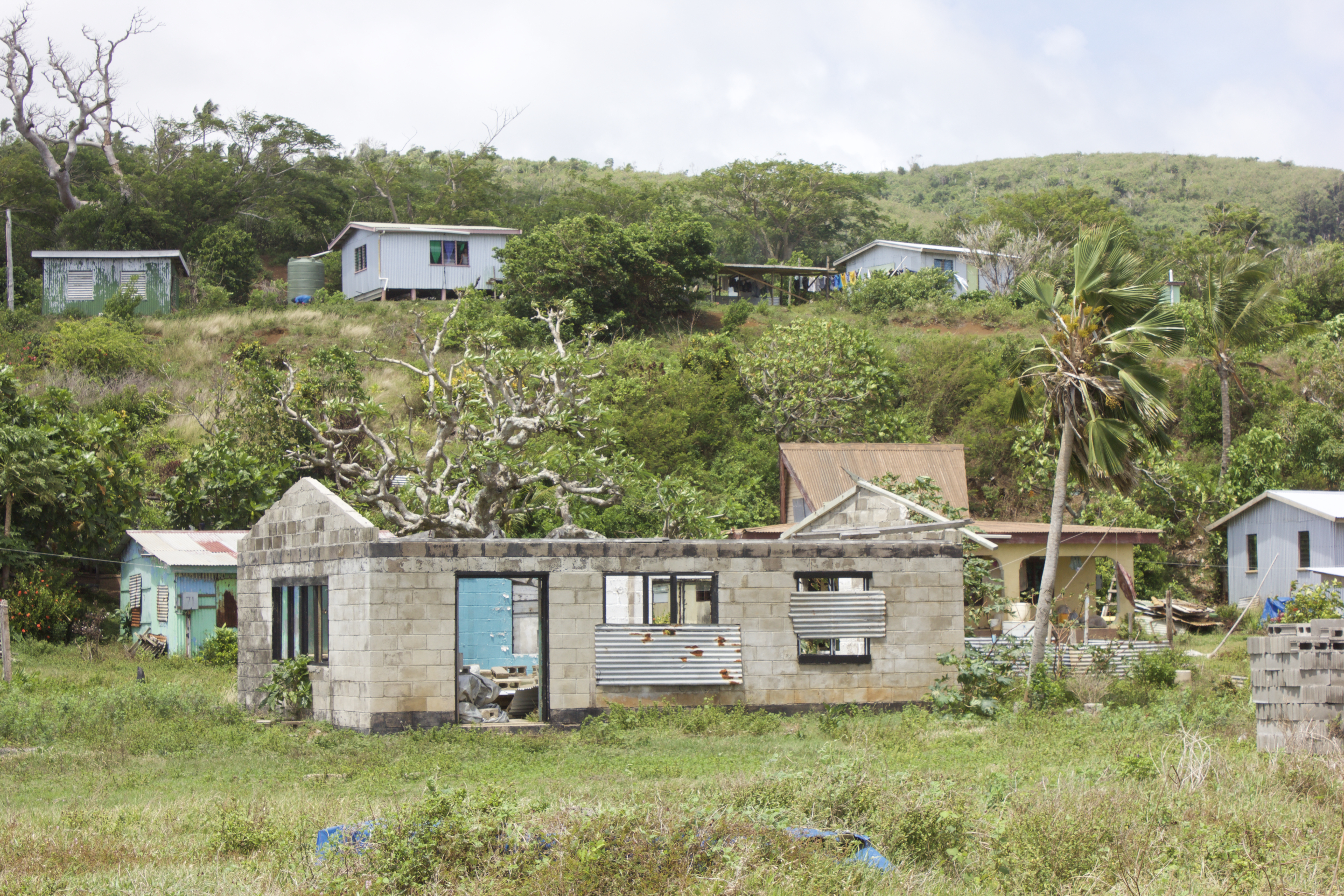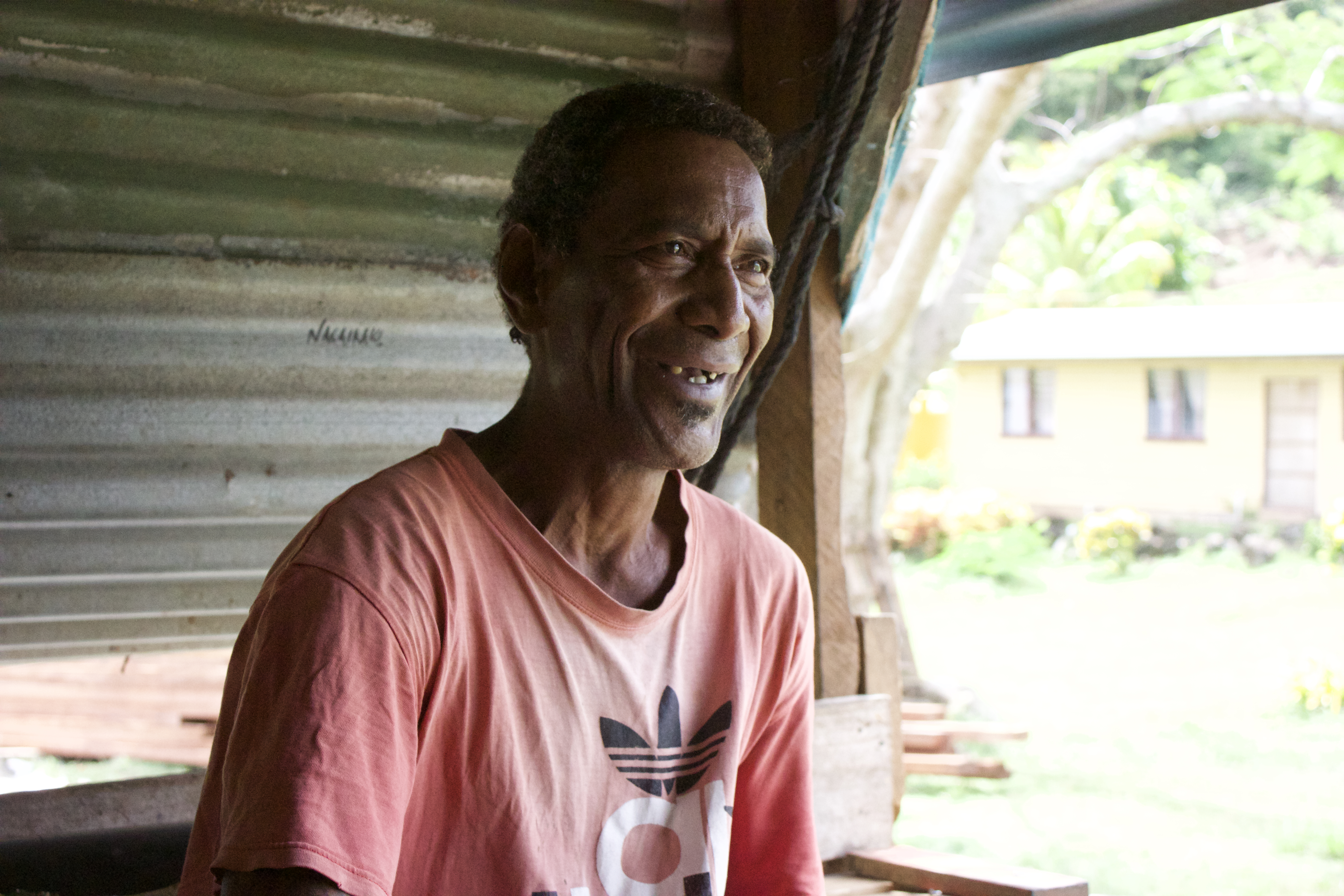

(Photo: Kate Wheeling/Pacific Standard)
Koro Island is one vast construction zone. On the roadside, cinderblocks and plastic piping are stacked in towering pyramids; trucks piled high with bags of “premium-quality cement” circle the island making deliveries; young men on rooftops or balancing on the wooden skeletons of new homes wave to the drivers as they crawl down the dirt and gravel roads. Everyone knows each other on this tiny Fijian island with fewer than 5,000 inhabitants; it takes less than an hour to drive around all of Koro.
On Koro, nearly every village is inching inland after Cyclone Winston in 2016. The Category 5 storm destroyed just about every structure on the island, forcing each of its 14 villages to start anew.
Today, new homes built to withstand Category 5 storms overlook neighborhoods of temporary structures built from the wreckage, some sturdier than others. Bright silver patches dot their corrugated metal walls where rust is eating away at the material. These were meant to be temporary shelters, while the families waited on the supplies for a new home. But, nearly two years on, the materials are still hard to come by. Carpenters with free time are even harder to find.
Most of the skilled laborers here are working on the island’s schools, all seven of which were flattened in the cyclone. Construction at most is still ongoing, but, earlier this year, children finally started to move back into fresh buildings with prominent Australian Aid signs in front. Still, some classrooms or teachers’ quarters and at least one entire school remain in UNICEF tents; officials had to identify a new location further inland for the school’s buildings before construction could begin.
“There’s always been a lot of relocating going on in the Pacific,” says Tammy Tabe, an expert on relocation and a lecturer at the University of the South Pacific in Suva. Large-scale migrations get all the news: Lots of people have heard about Vunidogoloa Village’s government-funded relocation from the coast of Fiji’s Vanua Levu further inland, for example, or Kiribati’s purchase of land in Fiji for a future where the island nation is submerged. But small-scale relocations tend to go undocumented, according to Tabe. In the past, those moves were often motivated by climate impacts like sea-level rise, coastal flooding, and erosion, but, more recently, natural disasters like Winston have become a driving force behind relocation.
For Koro’s coastal settlements, relocation was always an inevitability. “Even before the cyclone, I’ve been telling all my villagers, ‘In 10 years’ time, there will be no more village here,'” says Stino Naqarase, the 52-year-old headman of Nacamaki, and the village’s point of contact for the outside world. “I live by the sea; I saw the waves every day.” Sea-level rise was already consuming Nacamaki’s coast; Cyclone Winston was just the final straw. The village of Nacamaki was traumatized, Naqarase says; no one wanted to weather another storm of that magnitude from the low-lying village.

Nacamaki village used to sit on the sandy shoreline of Koro Island. Now, most of the houses still standing on the beach are shanties or mere shells: a foundation here, a wall there. This is the “red zone,” says Gele Tawake, a provincial officer for Lomaiviti, a province of Fiji that includes Koro Island. If anyone rebuilds in this area, which stretches from the shore to a point across the old village where the hill rises sharply up, they won’t receive government assistance after the next cyclone. Tawake points to the shoreline in front of the ruins, where the beachfront houses used to stand. There’s no sign that they ever existed at all.
One of those beachfront houses belonged to Naqarase, the village’s headman. “Everything disappeared,” he says, “even the septic tank.”
Naqarase wasn’t in his house when the storm picked up around 10 a.m. on February 20th, 2016. Many of the village’s 364 residents had evacuated to the town’s community center. The first wave took out the building’s wall, Naqarase recalls; the second, its roof. The villagers fled to a hillside plateau and huddled together outside on the ground for hours, hunched over to avoid debris carried by the winds. Each family took a census of its members, and the men of the village went back down into the chaos below to find the missing. Naqarase is stretched out on the floor of a building made from wood and tin that the storm ripped from their old homes, and his eyes glisten as he talks about that day in 2016.

(Photo: Kate Wheeling/Pacific Standard)
Winston stripped Koro of most of its vegetation, leaving the lush island brown and barren. Many of the island’s palm trees stand tall but frondless, snapped in half by the force of the winds. The island is draped in leafy green vegetation again, but crops were slower to recover.
For the first two months after the storm, Nacamaki’s residents lived off food they had stockpiled in the village store until government rations finally arrived. Eight months after Winston, the farmers tried to plant staple crops like cassava. “It never grew,” Naqarase says. They waited another five months for the rain to rid the soil of the salt left behind by the sea. The seeds finally took, and now the crops are growing even better than before.
Still, the fruit bats have yet to return. “Before Cyclone Winston, mangos don’t get ripe here in this village, this island,” Naqarase says; the fruit bats would always get them first. Indeed on the big island of Viti Levu, the ground beneath mango trees is often littered with mango seeds, stripped of their flesh by flying foxes. Now on Koro, mangos fall to the ground untouched. But Naqarase doesn’t share this story as a silver lining. “Maybe it’s good or maybe bad,” he says, “because some of us, we eat bats too.”
Which goes to show that, whether or not Nacamaki and Koro’s other relocating villages are thriving, post-Winston is still up for debate. Accessibility to food and water is just one factor that influences the success of a community at a new site, according to Tabe. Though no best practices for relocation yet exist, and any future guidelines will vary by community and how far they must move, Tabe believes that community cohesion and psychological well-being are as important as access to resources in internal migrations such as those on Koro.
“Trying to facilitate relocation itself is very complex,” Tabe says. “A lot of focus is usually put toward [the process of relocation] and not so much the aftermath.”
The people of Nacamaki banded together after the storm to support each other—as Fijians, an especially pious people, are wont to do. The water system is in place, and wiring for electricity will be done soon, but that hasn’t stopped more than 100 residents from leaving the close-knit community after the storm; according to Naqarase, the population of Nacamaki is down to 211.
“It’s not only resources or infrastructures that you’re looking at, but you’re looking also at the people and the psychological effect of being relocated,” Tabe says. “People are connected to the land. If they’re relocated it’s more than just being physically moved from one location to another, it has spiritual and cultural connotations to it.”
The close relationship between location and identity across the Pacific islands is more of an issue for inter-island or international relocations. On Koro, most of the villages are not moving very far from the old sites. But one challenge that remains for Koro’s villages is that the elders and ancestors in their cemeteries can’t come with them. Many of the island’s coastal graveyards were washed out by the storm. The road around the island used to pass by Nakodu—Tawake’s home village—on land that no longer exists. It was washed away during Winston. The new road crosses directly through the site of the cemetery; if you stand on the road and look toward the ocean, you’ll see shattered tombstones peeking out of the sand.
In the village of Nasau, the storm washed bones from the cemetery into the village, according to Litia Ditamana, a 25-year-old mother of two. But there are no plans yet to relocate the cemeteries. These are the spaces designated as burial grounds by their elders, according to Litia; in reverence to their authority, the cemetery site is unlikely to be moved before it’s completely underwater. Besides, she says, on such a small island, there’s nowhere else for them to go.




